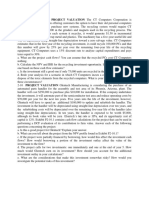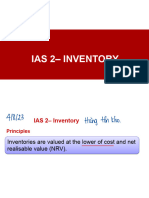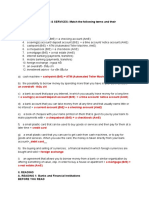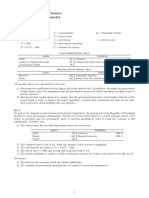Question 1 (Accounting)
Question 1 (Accounting)
Uploaded by
David DavidCopyright:
Available Formats
Question 1 (Accounting)
Question 1 (Accounting)
Uploaded by
David DavidOriginal Description:
Original Title
Copyright
Available Formats
Share this document
Did you find this document useful?
Is this content inappropriate?
Copyright:
Available Formats
Question 1 (Accounting)
Question 1 (Accounting)
Uploaded by
David DavidCopyright:
Available Formats
Question-1
Helix Company produces several products in its factory, including a karate robe. The company uses a standard cost
system to assist in the control of costs. According to the standards that have been set for the robes, the factory should
work 1,000 direct labor-hours each month and produce 2,000 robes. The standard costs associated with this level of
production are as follows:
Total
Per
Unit
of Product
Direct materials
41,400
$ 20.70
Direct labor
8,000
4.00
3,400
1.70
Variable
manufacturing
overhead
(based on direct labor-hours)
$ 26.40
During April, the factory worked only 1,100 direct labor-hours and produced 2,400 robes. The following actual costs
were recorded during the month:
Per
Unit
of Product
Total
Direct materials (8,200 yards)
48,000
$ 20.00
Direct labor
10,080
4.20
4,320
1.80
Variable manufacturing overhead
$ 26.00
At standard, each robe should require 3.00 yards of material. All of the materials purchased during the month were
used in production.
1.
2.
3.
Compute the materials price and quantity variances for April: (Indicate the effect of each variance by
selecting "F" for favorable, "U" for unfavorable, and "None" for no effect (i.e., zero variance).
Round your intermediate calculations to 2 decimal places.)
Compute the labor rate and efficiency variances for April:(Indicate the effect of each variance by
selecting "F" for favorable, "U" for unfavorable, and "None" for no effect (i.e., zero variance).
Round your intermediate calculations to 2 decimal places.)
Compute the variable manufacturing overhead rate and efficiency variances for April: (Indicate the effect
of each variance by selecting "F" for favorable, "U" for unfavorable, and "None" for no effect (i.e.,
zero variance). Round your intermediate calculations to 2 decimal places.)
1. Compute the materials price and quantity variances for April:
SolutionStandard Quantity Allowed for
Actual Output, at Standard Price
(SQ*SP)
Actual Quantity of input, at
Standard Price (AQ*SP)
Actual Quantity of input,
at Actual Price (AQ*AP)
7,200 yards**$6.9 per
Yard=$49,680
8,200 yards*$6.9 per
Yard=$56,580
$48,000
*$20.70/3.0 Yards=$6.9 per Yard
**2,400 Units*3.0 yards per unit = 7,200 Yards
Material Quantity Variance=$49,680-$56,580= $6,900U
Material Price Variance=$56,580-$48,000= $8,580F
Spending Variance=$6,900-$8,580=$1,680F
2. Compute the labor rate and efficiency variances for April:
SolutionStandard Hours Allowed for
Actual Output, at Standard Rate
(SH*SR)
Actual Hours of input, at
Standard Rate (AH*SR)
Actual Hours of input, at
Actual Rate(AQ*AP)
480 hours*$20.00 per
hour=$9,600
1,100 hours*$20.00 per
hour=$22,000
$10,080
*1,000 standard hours/ 2,000robes=0.2 standard hours per robe
$4.0 standard cost per robe/0.2 standard hours = $20.0 standard rate
**2,400 robes*0.2 standard hours per robe = 480 standard hours
Labor efficiency Variance=$9,600-$22,000= $12,400F
Labor rate Variance=$22,000-$10,080= $11,920U
Spending Variance=$12,400-$11,920=$480F
3. Compute the variable manufacturing overhead rate and efficiency variances for April:
SolutionVariable Overhead Spending Variance = AH x (AR-SR) =1,100 hours ($3.92 per hour -$20.00 per hour) =$17,688F
Variable Overhead Efficiency Variance = SR x (AH-SH) =$3.92 per hour (1,100 hours-480 hours)=$2,430U
Total Variable Overhead Variance = SV + EV = =$17,688F +$2,430U=$15,258U
You might also like
- Captainghostly Pattern - ChainsawDocument4 pagesCaptainghostly Pattern - ChainsawM RADITH ALIFANKA100% (1)
- Standard CostDocument4 pagesStandard CostZiad MohammedNo ratings yet
- Case Study Performance Lawn EquipmentDocument1 pageCase Study Performance Lawn EquipmentEhsan ElahiNo ratings yet
- Resource PlanningDocument15 pagesResource PlanningMAI NGUYỄN THÁI NHẬTNo ratings yet
- Pestel Analysis of CanadaDocument10 pagesPestel Analysis of Canadamalevivek90% (10)
- Stock SolutionDocument9 pagesStock Solution신동호No ratings yet
- Practice 1Document3 pagesPractice 1Ngọc TrầnNo ratings yet
- Boston Red Sox Spring Training Decision Case StudyDocument3 pagesBoston Red Sox Spring Training Decision Case StudyJairo Ojeda0% (1)
- Exercises 270919Document3 pagesExercises 270919Kim AnhNo ratings yet
- Engine Systems Business Unit: Process Capability Checks (PCC) According ASPICE Implementation May 11, 2017Document20 pagesEngine Systems Business Unit: Process Capability Checks (PCC) According ASPICE Implementation May 11, 2017sunithaNo ratings yet
- Walt DisneyDocument2 pagesWalt DisneyPam Palonpon100% (1)
- DEADLINE 12h trưa CN (7/5) : Lên bảng sửa Ex 1,2,4 Resource ManagementDocument21 pagesDEADLINE 12h trưa CN (7/5) : Lên bảng sửa Ex 1,2,4 Resource ManagementNGAN NGUYEN NGOC THAONo ratings yet
- Mock Test 2021 PMDocument5 pagesMock Test 2021 PMBao Thy PhoNo ratings yet
- FR MarchDocument17 pagesFR MarchGenoso OtakuNo ratings yet
- Accounting Chapter 4 SolutionsDocument14 pagesAccounting Chapter 4 Solutionsali sherNo ratings yet
- Solutions To Suggested Practice Questions - Chapter 26Document5 pagesSolutions To Suggested Practice Questions - Chapter 26Purna ChoudharyNo ratings yet
- Spartans CaseDocument1 pageSpartans CaseSaran SeeranganNo ratings yet
- Part 3: Cloze: Practice 1Document3 pagesPart 3: Cloze: Practice 1Nhung TrầnNo ratings yet
- Bài Thi Giữa Kỳ Môn Kế Toán ÚcDocument14 pagesBài Thi Giữa Kỳ Môn Kế Toán ÚcTrang LêNo ratings yet
- Practice Test Paper (Executive) - 1Document91 pagesPractice Test Paper (Executive) - 1isha raiNo ratings yet
- GK Cmbctcqt2 Nhóm 8 Dhktkt16bDocument9 pagesGK Cmbctcqt2 Nhóm 8 Dhktkt16bPhan Thị Mỹ DuyênNo ratings yet
- End of Chapter Exercises: Solutions: Answer: (I) Expected Opportunity Cost of $86 (Ii) Expected Opportunity Cost of $83Document2 pagesEnd of Chapter Exercises: Solutions: Answer: (I) Expected Opportunity Cost of $86 (Ii) Expected Opportunity Cost of $83opi ccxv100% (1)
- F2Document17 pagesF2TRINH DUC DIEPNo ratings yet
- Aquatech Is A U S Based Company That Manufactures Sells and InstallsDocument1 pageAquatech Is A U S Based Company That Manufactures Sells and Installstrilocksp SinghNo ratings yet
- Exercise Exercise 3.1 Component Accounting - Engine: Costs of PurchaseDocument15 pagesExercise Exercise 3.1 Component Accounting - Engine: Costs of PurchaseVõ Kim loanNo ratings yet
- De 3.2Document6 pagesDe 3.2minh trungNo ratings yet
- HOMEWORK W5 - UyênDocument6 pagesHOMEWORK W5 - UyênUyên TrịnhNo ratings yet
- Ias 02 InventoryDocument20 pagesIas 02 Inventorydương nguyễn vũ thùyNo ratings yet
- ACTDocument3 pagesACTNgô Lan TườngNo ratings yet
- Inventory Management: by Anita Lee-PostDocument20 pagesInventory Management: by Anita Lee-PostaruunstalinNo ratings yet
- ECO121 FA24 Individual Assignment 2Document2 pagesECO121 FA24 Individual Assignment 2tranleminh266No ratings yet
- Some Lessons From Capital Market History: Answers To Concepts Review and Critical Thinking Questions 1Document13 pagesSome Lessons From Capital Market History: Answers To Concepts Review and Critical Thinking Questions 1Sindhu JattNo ratings yet
- I. Starting Up B. BANKING PRODUCTS & SERVICES: Match The Following Terms and Their DefinitionsDocument7 pagesI. Starting Up B. BANKING PRODUCTS & SERVICES: Match The Following Terms and Their DefinitionsANH LƯƠNG NGUYỄN VÂNNo ratings yet
- Chapter 1 - International Financial Markets & MNCsDocument97 pagesChapter 1 - International Financial Markets & MNCsDung VươngNo ratings yet
- Final Guest Speaker Report - WORK 5570Document4 pagesFinal Guest Speaker Report - WORK 5570Pratik ShahNo ratings yet
- Chapter 4Document23 pagesChapter 4prudy.cezyNo ratings yet
- ECO111 Microeconomics Class: Handed Out: Submission Due: Format: Submission Mode: Email ToDocument6 pagesECO111 Microeconomics Class: Handed Out: Submission Due: Format: Submission Mode: Email ToQuỳnh Anh PhạmNo ratings yet
- Đề 2022 2023Document11 pagesĐề 2022 2023buitrantuuyen2003No ratings yet
- Chapter 8 MIS AnswersDocument19 pagesChapter 8 MIS AnswersConnor Day0% (1)
- Practical 02 - Google Teachable MachineDocument4 pagesPractical 02 - Google Teachable MachineThien ThanhNo ratings yet
- Kic02 Nhóm9 Topic2 Ktqt1enDocument10 pagesKic02 Nhóm9 Topic2 Ktqt1enLy BùiNo ratings yet
- Chapter 4Document3 pagesChapter 4Ngao BáiNo ratings yet
- Forecast Problems-PracticeDocument2 pagesForecast Problems-PracticeMuhammed Husain MusaniNo ratings yet
- Giáo Trình Reading Level 3Document83 pagesGiáo Trình Reading Level 3Hêu LanNo ratings yet
- Excersice VATDocument2 pagesExcersice VATThu HươngNo ratings yet
- Accounting Textbook Solutions - 34Document19 pagesAccounting Textbook Solutions - 34acc-expertNo ratings yet
- Chapter 4Document30 pagesChapter 4saudafmNo ratings yet
- Nguyễn Tuyết Anh Mkt1601 Hs160025 Eco121 Individual Assignment 03Document3 pagesNguyễn Tuyết Anh Mkt1601 Hs160025 Eco121 Individual Assignment 03Trần Trác Tuyền Vietnam Fanpage Sweet DreamNo ratings yet
- ECO121 - Individua - assignment - Nguyễn Như Cường - HS153103Document3 pagesECO121 - Individua - assignment - Nguyễn Như Cường - HS153103Nguyen Thanh Tung (K15 HL)No ratings yet
- (ACCT2010) (2012) (F) Quiz Hzhongaa 49127Document13 pages(ACCT2010) (2012) (F) Quiz Hzhongaa 49127Brenda WijayaNo ratings yet
- TEST 1 - MACRO - GPD - CPI - 50 CâuDocument10 pagesTEST 1 - MACRO - GPD - CPI - 50 CâuTrần Toàn100% (1)
- Homework 7&9 of LeanDocument15 pagesHomework 7&9 of LeanYe QiuNo ratings yet
- Two Exercises About The is-LM ModelDocument2 pagesTwo Exercises About The is-LM ModelMatheus AugustoNo ratings yet
- Project Report: Foreign Trade University School of Economics and International BusinessDocument29 pagesProject Report: Foreign Trade University School of Economics and International BusinessPhạm Việt BáchNo ratings yet
- Midterm: Hoa Lac Subject: Principles of Accounting (Acc101) Duration: .. Minutes Student InformationDocument2 pagesMidterm: Hoa Lac Subject: Principles of Accounting (Acc101) Duration: .. Minutes Student InformationNguyen Ngoc Minh Chau (K15 HL)No ratings yet
- 01 - Case StudyDocument2 pages01 - Case Studyfiji joseNo ratings yet
- Take Note Kế Toán Quốc TếDocument6 pagesTake Note Kế Toán Quốc TếPhuong DungNo ratings yet
- Case Study - AuditingDocument5 pagesCase Study - AuditingPhương Huyền LêNo ratings yet
- Thi Két Thúc HQC Phan B4C Ð41 HQC Chính QUY Kÿ 11 Näm HQC 2018 - 2019Document11 pagesThi Két Thúc HQC Phan B4C Ð41 HQC Chính QUY Kÿ 11 Näm HQC 2018 - 2019Sơn Thạch BùiNo ratings yet
- QS12 - Midterm 2 Review SolutionDocument7 pagesQS12 - Midterm 2 Review Solutionlyk0tex0% (1)
- Review Problem 1: Variance Analysis Using A Flexible Budget: RequiredDocument12 pagesReview Problem 1: Variance Analysis Using A Flexible Budget: RequiredGraieszian Lyra100% (1)
- Managerial Accounting by Garrison Appendix 12B34 MASDocument29 pagesManagerial Accounting by Garrison Appendix 12B34 MASJoshua Hines0% (1)
- Standard Costing ExercisesDocument6 pagesStandard Costing ExercisesVatchdemonNo ratings yet
- AccountingDocument14 pagesAccountingDavid DavidNo ratings yet
- 18e Key Question Answers CH 8Document4 pages18e Key Question Answers CH 8David DavidNo ratings yet
- Sheet1: Accounting Rate of Return (11000/30000) 100 36.67%Document12 pagesSheet1: Accounting Rate of Return (11000/30000) 100 36.67%David DavidNo ratings yet
- 336 Homework 3Document1 page336 Homework 3David DavidNo ratings yet
- 202E08Document22 pages202E08David David100% (1)
- 11Document3 pages11David DavidNo ratings yet
- Financial MarketDocument14 pagesFinancial MarketDavid DavidNo ratings yet
- Lecture 4 Public GoodsDocument2 pagesLecture 4 Public GoodsDavid David100% (1)
- Assign 3 Jones MDocument5 pagesAssign 3 Jones MDavid DavidNo ratings yet
- 2010-05-12 052533 OrangeDocument1 page2010-05-12 052533 OrangeDavid DavidNo ratings yet
- Tutor WhiteboardDocument4 pagesTutor WhiteboardDavid DavidNo ratings yet
- 2010-07-24 150310 BaxterDocument1 page2010-07-24 150310 BaxterDavid DavidNo ratings yet
- Problem 9-20 (120 Minutes) : Januar y Februar y March QuarterDocument5 pagesProblem 9-20 (120 Minutes) : Januar y Februar y March QuarterDavid DavidNo ratings yet
- Chapter 2 Accounting For Materials: Review SummaryDocument15 pagesChapter 2 Accounting For Materials: Review SummaryDavid DavidNo ratings yet
- 2008-11-06 154427 Marsh CompanyDocument8 pages2008-11-06 154427 Marsh CompanyDavid David100% (1)
- Financial MarketDocument7 pagesFinancial MarketDavid DavidNo ratings yet
- Nternational Business Law Joint Venture September 20101Document41 pagesNternational Business Law Joint Venture September 20101David DavidNo ratings yet
- CH 14Document47 pagesCH 14David DavidNo ratings yet
- Mahamaya Technicaluniversity, Noida: Syllabus For First Year of Master of Business Administration (Mba)Document34 pagesMahamaya Technicaluniversity, Noida: Syllabus For First Year of Master of Business Administration (Mba)David DavidNo ratings yet
- JkkjkdskjdklsjdshdjskhdhghdsDocument1 pageJkkjkdskjdklsjdshdjskhdhghdsDavid DavidNo ratings yet
- 2010 Suzuki Grand Vitara Technical SpecsDocument1 page2010 Suzuki Grand Vitara Technical SpecsadiazramNo ratings yet
- TQM MotorolaDocument16 pagesTQM Motorolaapurvaj14No ratings yet
- Smith-Blair Type 274 Bell Joint Leak ClampDocument4 pagesSmith-Blair Type 274 Bell Joint Leak ClampDGWNo ratings yet
- Cooper Nature: Air-Insulated Metal-Clad Enclosed Switchgear Fitted With VN3, VD4 Withdrawable Vacuum Circuit BreakerDocument32 pagesCooper Nature: Air-Insulated Metal-Clad Enclosed Switchgear Fitted With VN3, VD4 Withdrawable Vacuum Circuit BreakerMahyar Mashayekhi50% (2)
- Dayton Steering 222Document160 pagesDayton Steering 222Felipe montanaNo ratings yet
- Mopar Accessories Jeep RamDocument38 pagesMopar Accessories Jeep RamlinseysabrinaNo ratings yet
- 03 Knowledge Sharing 7 QC ToolsDocument107 pages03 Knowledge Sharing 7 QC Toolsravi javaliNo ratings yet
- Valvulas PSV FarrisDocument94 pagesValvulas PSV FarrisdieferjimenezNo ratings yet
- BS en 13423 - 2000Document12 pagesBS en 13423 - 2000Luís SilvaNo ratings yet
- DW Basic + UnixDocument31 pagesDW Basic + UnixbabjeereddyNo ratings yet
- Movement TypesDocument11 pagesMovement TypesscribdatlantaNo ratings yet
- BENZZDocument26 pagesBENZZManimegalai PrasannaNo ratings yet
- Internship Report 374Document14 pagesInternship Report 374LAKKANABOINA LAKSHMANARAO80% (5)
- What Is A Data Warehouse?Document48 pagesWhat Is A Data Warehouse?Kishori PatilNo ratings yet
- Features of Application Software PackagesDocument6 pagesFeatures of Application Software PackagesrangarajantrNo ratings yet
- Detailed Adv. - JENDocument7 pagesDetailed Adv. - JENPriyanka SharmaNo ratings yet
- ESKATE Rectangular Square Flange 24193 4Document1 pageESKATE Rectangular Square Flange 24193 4John DoeNo ratings yet
- Service Life Planning of Building Components The Brazilian ExperienceDocument60 pagesService Life Planning of Building Components The Brazilian ExperienceOvelhaNo ratings yet
- 1500 ITT Training QuestionsDocument166 pages1500 ITT Training QuestionsMallikarjun Reddy ChagamreddyNo ratings yet
- Mr2 (MR Industry)Document2 pagesMr2 (MR Industry)Chetan GaikwadNo ratings yet
- 1Document16 pages1JimHammerandNo ratings yet
- Instrument Landing System LocalizerDocument4 pagesInstrument Landing System LocalizerWin MinNo ratings yet
- Revaho BV: General Information: Visiting AddressDocument6 pagesRevaho BV: General Information: Visiting AddressПетр НикольскийNo ratings yet
- 06 - 3) Service Procurement Process in SAP MM - S4 HANA - ECC - #Sap #Sapmm #Sapmmtraining - EnglishDocument21 pages06 - 3) Service Procurement Process in SAP MM - S4 HANA - ECC - #Sap #Sapmm #Sapmmtraining - EnglishMedi Srikanth NethaNo ratings yet
- Formula Bharat Rulebook Summary UpdatedDocument12 pagesFormula Bharat Rulebook Summary UpdatedSubarna RegmiNo ratings yet
- Nakajima Oscar Paper AirplaneDocument4 pagesNakajima Oscar Paper Airplaneozar359No ratings yet
- SBN Corp Profile - 2 PDFDocument33 pagesSBN Corp Profile - 2 PDFSyafiq KamaluddinNo ratings yet













































































































